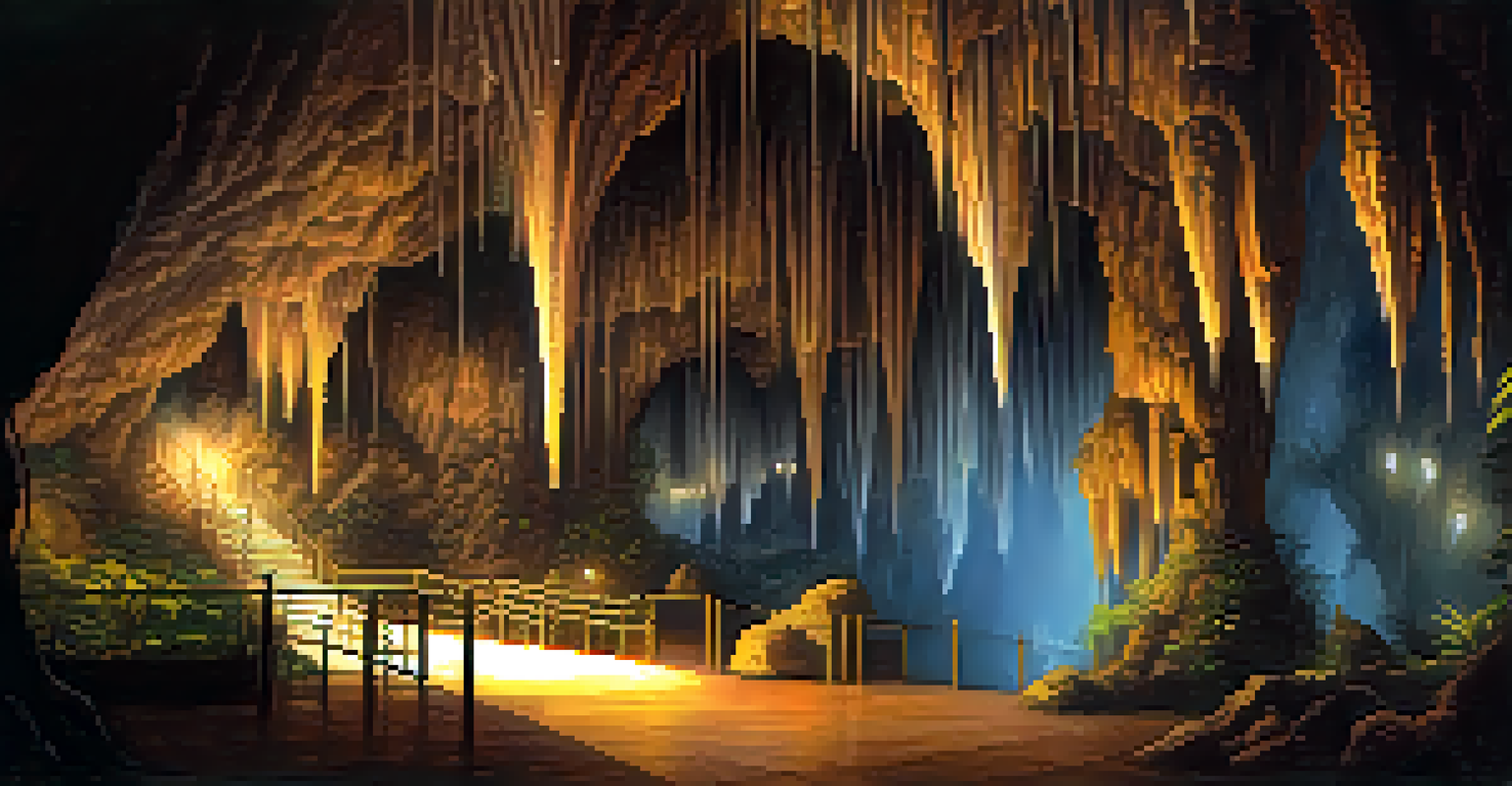Exploring Thailand’s Unique Geological Formations: Nature’s Art

Thailand: A Geological Wonderland of Wonders
Thailand is not just known for its vibrant culture and delicious cuisine; it is also a treasure trove of unique geological formations. From towering limestone cliffs to intricate cave systems, the country's natural landscape offers a stunning showcase of Earth’s artistic capabilities. Each formation tells a story, shaped by millions of years of geological processes, including erosion, volcanic activity, and sedimentation.
Nature does not hurry, yet everything is accomplished.
Imagine standing before a majestic karst mountain, its sheer cliffs rising dramatically from the ground, covered in lush greenery. These limestone formations, prevalent in places like Krabi and Phang Nga Bay, are not only breathtaking but also serve as a reminder of the dynamic forces that have sculpted our planet. The vibrant colors and unusual shapes often leave visitors awestruck, making Thailand a must-visit for nature lovers and geology enthusiasts alike.
As you traverse the country, you'll find that each region boasts its own geological wonders. Whether you're exploring the intricate cave systems in Chiang Dao or the unique rock formations of Pai, Thailand's geological diversity is truly a feast for the eyes.
The Magnificent Limestone Karsts of Krabi
Krabi is famous for its stunning limestone karsts, which rise dramatically from the turquoise waters of the Andaman Sea. These towering formations create a striking contrast against the sea and sky, making them one of the most photographed landscapes in Thailand. The karsts are not just beautiful; they also provide habitat for diverse marine life and rich ecosystems, highlighting the importance of preservation efforts in these areas.

Visitors to Krabi can explore these limestone giants through various activities such as rock climbing, kayaking, and hiking. For example, Railay Beach, accessible only by boat, is surrounded by impressive cliffs and offers climbing routes for all skill levels. The thrill of scaling these natural walls while enjoying breathtaking views is an experience that adventure seekers won't want to miss.
Thailand's Geological Diversity Shines
The country's unique geological formations, from limestone cliffs to intricate caves, showcase Earth's artistic capabilities and offer a feast for nature lovers.
Moreover, the karsts have deep cultural significance as well, often featuring in local legends and traditions. This connection between nature and culture enriches the experience, making a visit to Krabi not just a visual delight but also a journey through Thailand's rich heritage.
Exploring the Enigmatic Caves of Chiang Dao
Chiang Dao, located in northern Thailand, is home to one of the country's largest cave systems, the Chiang Dao Cave. This labyrinth of tunnels and chambers is adorned with stunning stalactites and stalagmites, creating an otherworldly atmosphere. As you wander through the caves, you'll encounter various chambers, each with its own unique formations that seem to have been crafted by nature's hand.
The earth has music for those who listen.
The caves hold spiritual significance as well, with several shrines and Buddha images nestled within their depths. Local monks often use these serene surroundings for meditation and reflection, adding a layer of tranquility to your visit. Exploring the caves not only offers an adventure for the senses but also a glimpse into the spiritual practices of the region.
For the adventurous at heart, guided tours are available, allowing you to delve deeper into this underground wonderland. As you journey through the cool, dark passages, you'll appreciate the natural beauty and geological history that have shaped this remarkable site over thousands of years.
The Striking Rock Formations of Pai
Pai, a charming town in northern Thailand, is renowned for its stunning rock formations that are both intriguing and beautiful. The Pai Canyon, often referred to as the 'Grand Canyon of Thailand,' features narrow red clay paths and steep cliffs that provide breathtaking views of the surrounding landscape. This natural wonder is a favorite among photographers and hikers alike, offering a unique perspective on the beauty of Thai nature.
As the sun sets, the canyon transforms into a magical place, bathed in golden light. The contrast of the warm hues against the rugged terrain creates a picturesque scene that leaves visitors in awe. The serene atmosphere and stunning vistas make Pai Canyon a perfect spot for reflection and connection with nature.
Preservation of Natural Wonders is Vital
As tourism and climate change threaten these geological treasures, responsible practices and conservation efforts are essential to protect them for future generations.
Additionally, the rock formations in Pai are not just visually striking; they are also a testament to the region's geological history. The unique shapes and patterns tell a story of the Earth’s evolution, making Pai a fascinating destination for geology enthusiasts and casual travelers alike.
The Colorful Stone Formations of Phang Nga Bay
Phang Nga Bay is famous for its dramatic limestone cliffs that rise steeply from emerald waters, creating a stunning seascape. The bay is dotted with numerous islands, each featuring unique stone formations that are often adorned with lush vegetation. Among the most iconic sights is James Bond Island, known for its striking limestone karst that juts out of the sea like a sentinel guarding the bay.
Exploring Phang Nga Bay by boat offers a unique perspective on these geological wonders. You can glide through hidden lagoons and marvel at the towering cliffs that seem to touch the sky. The interplay of light and shadow on the rocks creates a visual spectacle that captivates visitors, making it a photographer's paradise.
Moreover, the bay's ecological richness adds another layer to its appeal. The mangroves and coral reefs that thrive in the surrounding waters support a diverse range of marine life, making Phang Nga Bay not only a geological marvel but also an essential ecosystem worth protecting.
The Natural Beauty of Doi Inthanon National Park
Doi Inthanon, the highest peak in Thailand, is located within a national park that showcases an array of stunning geological features. The park is known for its waterfalls, lush forests, and unique rock formations, making it an ideal destination for nature lovers and outdoor enthusiasts. Hiking trails lead you through diverse ecosystems, offering glimpses of the park's rich biodiversity.
One of the highlights of Doi Inthanon is the breathtaking Wachiratharn Waterfall, where water cascades down rocky cliffs, surrounded by vibrant greenery. The sound of rushing water and the cool mist create a tranquil atmosphere, perfect for a refreshing break during your explorations. Here, visitors can connect with nature and witness the power of water shaping the landscape.
Cultural Significance of Rock Formations
Many of Thailand's geological sites hold deep cultural connections, enriching visitors' experiences by intertwining nature with local heritage and traditions.
Additionally, the park is home to the famous King and Queen Pagodas, which are built on the summit. These structures not only offer stunning views but also serve as a reminder of the region's cultural heritage. The juxtaposition of nature's beauty and human artistry creates an unforgettable experience for all who visit.
The Mystical Rock Formations of Sukhothai
Sukhothai, a UNESCO World Heritage Site, is not only known for its historical significance but also for its fascinating rock formations. The ancient ruins are interspersed with unique geological structures that enhance the area's charm. As you walk through the historical park, you'll encounter crumbling temples and statues that appear to rise organically from the landscape, blending history with nature.
The interplay of the ancient architecture and the surrounding formations creates a mystical atmosphere, inviting visitors to reflect on the passage of time. The towering rock structures, often draped in lush greenery, add an enchanting backdrop to the historical sites, making it a photographer’s dream.

Exploring Sukhothai allows you to appreciate the natural beauty that has coexisted with human history for centuries. The connection between the geological formations and the ancient ruins illustrates how nature and culture are intertwined, offering a rich tapestry of experiences for those who venture here.
Preserving Thailand's Geological Treasures
As we marvel at Thailand's unique geological formations, it’s essential to recognize the importance of preservation. These natural wonders are not only vital for biodiversity but also serve as cultural and historical landmarks. Unfortunately, many of these sites face threats from tourism, climate change, and human activities, underscoring the need for responsible practices and conservation efforts.
Engaging in eco-friendly tourism can help protect these geological treasures for future generations. Simple actions, such as staying on marked paths, minimizing waste, and respecting local wildlife, can make a significant difference. By choosing to support local conservation initiatives, travelers can contribute to the preservation of these beautiful landscapes.
Ultimately, the responsibility lies with all of us to ensure that Thailand's geological formations continue to inspire wonder and appreciation. By fostering a greater understanding of their significance, we can work together to protect these natural masterpieces, allowing future visitors to experience the beauty of nature's art.